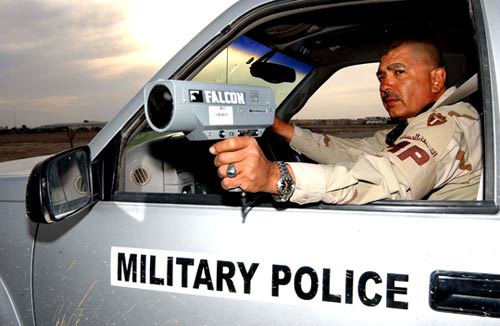 |
| Army MP using radar in Iraq |
Basics of a Doppler Radar
 |
| Doppler effect model showing compressed waves on the right as the object moves toward something and decompressed waves on the left side as it moves away |
On some car radar detector, you may see that they can detect Ka and X band radar which tells you what frequency they are transmitting at. Police usually use radars with a frequency of Ka or X which are about 35 GHz or 10 GHz, respectively. 35 MHz means the radar wave fluctuated up and down 35 billion times per second. For comparison, an over the air TV signal transmits at UHF which is between 400 and 800 MHz (400 to 800 million hertz) and light transmits at 430 THz (trillion hertz) for red and 750 THz (trillion hertz) for violet. Radars are what is called coherent which means the Doppler can be measured. The newer laser radar also called lidar, light radar, the police use are not coherent. So how do they work?
LIDAR Speed Guns
A lidar can measure speed based on repeatedly measuring the distance an object of interest. Police like lidars because they have a narrower beam which makes them less likely to get measurements from multiple cars and they are harder to jam. Instead of using radar, lidars use a beam frequency that is infrared which is not visible to the naked eye, but has similar properties to visible light like a much narrower beamwidth. Like a radar, a lidar can measure range based on the fact that light and all waves travel at the speed of about 300,000,000 meters/second or about 671,000,000 mph (the speed of light constant). A lidar measures the time between it transmits and receives a pulse, then multiples that time by the speed of light and divides by two (to account for the time it takes for the beam to travel to and from the object). For example, if you were 150 meters from the lidar it would take 0.000 001 seconds for the beam to transmit and be received by the lidar gun (300,000,000 m/s times 0.000 001s divided by 2). It then does that measurement many times in less than a second then calculates the change in distances over that period to calculate your speed. For example, you went from 150 meters away to 110 meters away in a second you were traveling 40 m/s or about 90 mph (and if a cop measured you would probably get pulled over).
 |
| Police officer with a lidar gun |
For both radar and lidar, the speed measurements are the most accurate if your car is going directly at the radar beam, since police or radar cameras are on the side of the road the speed measurement is not going to be the true speed you are going. Unfortunately, the speed the radar gun collects is slower than your actual speed, so it is not an error you can use to get out of a ticket.
Speed Gun Jammers
To counteract the radar guns some people use radar jammer or scramblers, you can read more about these in a previous blog, but basically the radar jammers figure out what frequency the police officer has and sends out a nonsense signal at the frequency so the cops gun cannot detect the speed. These jammers are generally illegal for civilians to have since they transmit high energy radio waves which are regulated by the Federal Communication Commission (FCC).
Lidar guns are much harder to detect and jam because laser beams are much narrower than radar (that is why most police agencies using them now), but a laser jammer works in the same way as radar jammer.
Most police point lidar guns at your front license plate since it is a flat surface and it will bounce back more directly to the lidar gun. To counter act that, some people use techniques that are used by stealth aircraft to counteract radar. Stealth airplanes use the fact that if the beam does not get back to the receiver, a measurement cannot be made, so they have body shapes that reflect the beam away from the receiver with offset shapes and have radar absorbing paint, so some dedicated people have lidar absorbing paint on their cars and license plates or have their license plates slanted so the beam will bounce in to the sky.
This game of coming up with counter-measures for radars and then coming up with counter-counter-measures radars is played by both drivers and police as well as militaries when it comes deceiving radar.